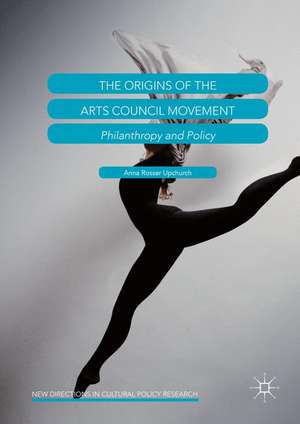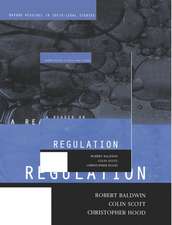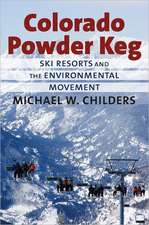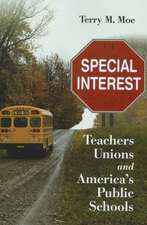The Origins of the Arts Council Movement: Philanthropy and Policy: New Directions in Cultural Policy Research
Autor Anna Rosser Upchurchen Limba Engleză Hardback – 28 noi 2016
Din seria New Directions in Cultural Policy Research
- 20%
 Preț: 876.51 lei
Preț: 876.51 lei - 11%
 Preț: 508.17 lei
Preț: 508.17 lei - 15%
 Preț: 464.50 lei
Preț: 464.50 lei -
 Preț: 389.70 lei
Preț: 389.70 lei -
 Preț: 382.75 lei
Preț: 382.75 lei - 15%
 Preț: 640.06 lei
Preț: 640.06 lei - 15%
 Preț: 640.55 lei
Preț: 640.55 lei - 15%
 Preț: 502.22 lei
Preț: 502.22 lei -
 Preț: 383.33 lei
Preț: 383.33 lei - 15%
 Preț: 527.66 lei
Preț: 527.66 lei - 15%
 Preț: 581.33 lei
Preț: 581.33 lei - 15%
 Preț: 527.97 lei
Preț: 527.97 lei - 18%
 Preț: 775.65 lei
Preț: 775.65 lei -
 Preț: 242.00 lei
Preț: 242.00 lei - 18%
 Preț: 722.43 lei
Preț: 722.43 lei - 18%
 Preț: 892.74 lei
Preț: 892.74 lei - 18%
 Preț: 780.19 lei
Preț: 780.19 lei - 18%
 Preț: 893.71 lei
Preț: 893.71 lei
Preț: 725.92 lei
Preț vechi: 885.27 lei
-18% Nou
Puncte Express: 1089
Preț estimativ în valută:
138.91€ • 145.32$ • 115.39£
138.91€ • 145.32$ • 115.39£
Carte tipărită la comandă
Livrare economică 02-16 aprilie
Preluare comenzi: 021 569.72.76
Specificații
ISBN-13: 9781137461629
ISBN-10: 1137461624
Pagini: 264
Ilustrații: XII, 214 p.
Dimensiuni: 148 x 210 x 19 mm
Greutate: 0.4 kg
Ediția:1st ed. 2016
Editura: Palgrave Macmillan UK
Colecția Palgrave Macmillan
Seria New Directions in Cultural Policy Research
Locul publicării:London, United Kingdom
ISBN-10: 1137461624
Pagini: 264
Ilustrații: XII, 214 p.
Dimensiuni: 148 x 210 x 19 mm
Greutate: 0.4 kg
Ediția:1st ed. 2016
Editura: Palgrave Macmillan UK
Colecția Palgrave Macmillan
Seria New Directions in Cultural Policy Research
Locul publicării:London, United Kingdom
Cuprins
Introduction. What is the ‘arts council movement’?.- 1.Philanthropists and Policy Advisors.- 2.The Ideologies of English Intellectualism and of American Philanthropy.- 3.Arts policy during the second world war in the United Kingdom.- 4.The Arts Council of Great Britain: Keynes’s Legacy.- 5.The Canadian Clerisy and the Canada Council.- 6.The Local Arts Council Movement in the United States.- Conclusion
Notă biografică
Anna Rosser Upchurch is Lecturer in Cultural Policy at the University of Leeds, UK. After a career in arts management and policy in the United States working for a range of publicly and privately funded organisations, she earned a PhD in cultural policy studies at the University of Warwick, UK. She is co-editor of Humanities in the Twenty-First Century: Beyond Utility and Markets (Palgrave Macmillan 2013), with Eleonora Belfiore, and her research interests include the historiography and theory of cultural policy, the history of ideas about the arts and humanities in society, including issues of ‘value’ and ‘impact’, and histories of women activists in cultural organisations.
Textul de pe ultima copertă
‘For anyone interested or involved in the arts – whether as a practitioner, administrator, researcher, or enthusiast – Upchurch's impressively-researched text is essential reading, clarifying the manner in which present-day arts policies and funding patterns are grounded in a problematic history of privilege, power, paternalism, politics, and patriarchy.’
– Alan Stanbridge, University of Toronto Scarborough, Canada
Caracteristici
Makes an important contribution to cultural policy research by offering new insights into an under-documented history Introduces a significant emphasis on the fundamentally gendered nature of the development of the arts council movement, by including a range of previously unheralded female actors into the narrative Highlights the manner in which powerful groups of cultural elites influenced public policy on arts and culture in a manner that remains embedded in cultural policy and arts funding patterns today













